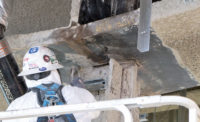As work on the Freedom Tower’s foundations progresses, with an eye to vertical construction beginning next year, observers are expressing doubts over the project’s total price tag, which seems poised to rise at a faster rate than the building itself.
Earlier this year, the Port Authority of New York and New Jersey officially authorized construction of the Skidmore Owings & Merrill-designed building, which forms the symbolic cornerstone of the rebuilt World Trade Center complex. The agency also approved the awarding of contracts worth nearly $500 million for continuing construction on the Freedom Tower’s foundations, which began last spring.
A press release stated that the contract amounts fall “within planned-for contingencies common to projects of this scale,” a roughly 4 percent margin. The building’s total price tag is currently set at $2.88 billion. But many observers believe that the final number will rise far higher.
Barry LePatner, Hon. AIA, a real estate attorney and construction cost expert, contends that the Freedom Tower’s initial bid numbers were virtually meaningless—unless construction companies agree to sign fixed-cost contracts, which seems unlikely. The problem, he explains, is that contractors often lowball their estimates to win projects and then file change orders and add other fees to make up the difference later.
Prominent real estate developers including Douglas Durst and Anthony Malkin have also criticized the project’s finances. Lower Manhattan has an oversupply of office space, they told The New York Times in February, and the Freedom Tower is struggling to attract commercial tenants aside from government agencies.
New York’s new governor, Eliot Spitzer, pledged his support to the Freedom Tower’s construction after taking office this winter—a symbolic but critical step. Even so, Spitzer as well as New Jersey governor Jon Corzine and New York City mayor Michael Bloomberg have said that they are open to selling it to a private developer, which could presumably redesign it. The foundations under construction now, they note, can be used for buildings other than the Freedom Tower.
Other projects at the World Trade Center site face a similarly uncertain fate. The Port Authority admitted this winter that rising labor and materials costs have caused the PATH station, designed by Santiago Calatrava, to exceed its $2.2 billion budget by as much as $1.2 billion. The architect and agency are looking for ways to trim costs. These could include a redesign, although Calatrava has said he is committed to preserving his design’s signature elements.
In other World Trade Center news, the Lower Manhattan Development Corporation (LMDC) has released a revised General Project Plan for construction projects at the World Trade Center site, spelling out the responsibilities of various stakeholders. New York City and New York State jointly created this agency in 2001 to oversee rebuilding at Ground Zero.
The LMDC, in cooperation with the World Trade Center Memorial Foundation, will build the 9/11 memorial and memorial museum. Another key player, the Port Authority of New York and New Jersey, will build the Freedom Tower, designed by Skidmore Owings & Merrill, the PATH transit terminal designed by Santiago Calatrava, and sub-surface infrastructure for the whole site.
This revised plan was included in the LMDC’s “Final Report,” outlining its activity since 2001. Although the agency has largely closed its operations, allocating many of its duties to other agencies and private corporations, it continues to administer grants and supervise several downtown projects.


Post a comment to this article
Report Abusive Comment